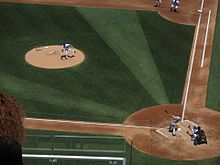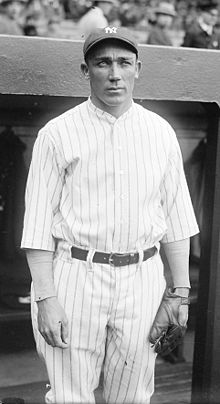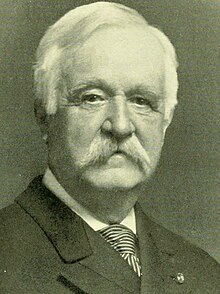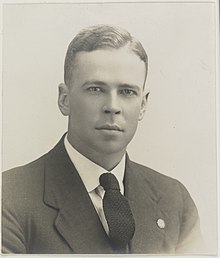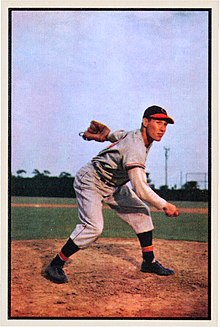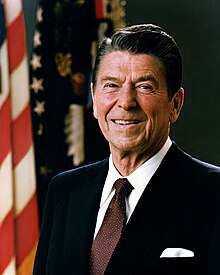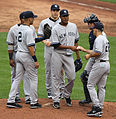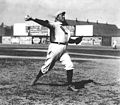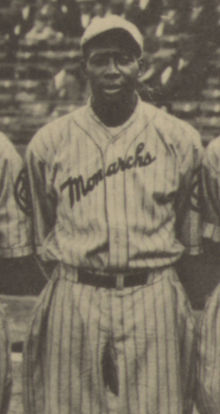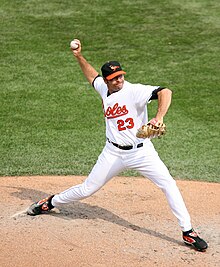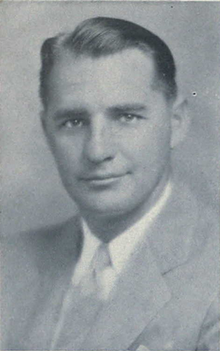Portal:Baseball
Portal maintenance status: (June 2018)
|
| Main page | Content, Categories & Topics | WikiProjects & Things you can do |
The Baseball Portal
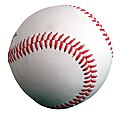
Baseball is a bat-and-ball sport played between two teams of nine players each, taking turns batting and fielding. The game occurs over the course of several plays, with each play generally beginning when a player on the fielding team, called the pitcher, throws a ball that a player on the batting team, called the batter, tries to hit with a bat. The objective of the offensive team (batting team) is to hit the ball into the field of play, away from the other team's players, allowing its players to run the bases, having them advance counter-clockwise around four bases to score what are called "runs". The objective of the defensive team (referred to as the fielding team) is to prevent batters from becoming runners, and to prevent runners advancing around the bases. A run is scored when a runner legally advances around the bases in order and touches home plate (the place where the player started as a batter).
The opposing teams switch back and forth between batting and fielding; the batting team's turn to bat is over once the fielding team records three outs. One turn batting for each team constitutes an inning. A game is usually composed of nine innings, and the team with the greater number of runs at the end of the game wins. Most games end after the ninth inning, but if scores are tied at that point, extra innings are usually played. Baseball has no game clock, though some competitions feature pace-of-play regulations such as the pitch clock to shorten game time.
Baseball evolved from older bat-and-ball games already being played in England by the mid-18th century. This game was brought by immigrants to North America, where the modern version developed. Baseball's American origins, as well as its reputation as a source of escapism during troubled points in American history such as the American Civil War and the Great Depression, have led the sport to receive the moniker of "America's Pastime"; since the late 19th century, it has been unofficially recognized as the national sport of the United States, though in modern times is considered less popular than other sports, such as American football. In addition to North America, baseball spread throughout the rest of the Americas and the Asia–Pacific in the 19th and 20th centuries, and is now considered the most popular sport in parts of Central and South America, the Caribbean, and East Asia, particularly in Japan, South Korea, and Taiwan. (Full article...)
 Featured articles - load new batch
Featured articles - load new batch
-
Image 1
Riders Field, formerly known as Dr Pepper/Seven Up Ballpark and Dr Pepper Ballpark, is a baseball park in Frisco, Texas, United States. The home of the Double-A Frisco RoughRiders of the Texas League, it opened on April 3, 2003, and can seat up to 10,216 people. Though primarily a venue for Minor League Baseball games, the facility also hosts high school and college baseball tournaments, and other public and private events throughout the year. It has been the site of three Texas League All-Star Games.
Since its opening, Riders Field has won awards and garnered praise for its unique design, feel, and numerous amenities. In his design, park architect David M. Schwarz desired the creation of a village-like "park within a (ball)park". The stadium received the 2003 Texas Construction Award for Best Architectural Design. (Full article...) -
Image 2Paschal before a game during the 1925 New York Yankees season
Benjamin Edwin Paschal (October 13, 1895 – November 10, 1974) was an American baseball outfielder who played eight seasons in Major League Baseball from 1915 to 1929, mostly for the New York Yankees. After two "cup of coffee" stints with the Cleveland Indians in 1915 and the Boston Red Sox in 1920, Paschal spent most of his career as the fourth outfielder and right-handed pinch hitter of the Yankees' Murderers' Row championship teams of the late 1920s. Paschal is best known for hitting .360 in the 1925 season while standing in for Babe Ruth, who missed the first 40 games with a stomach ailment.
During his time in baseball, Paschal was described as a five-tool player who excelled at running, throwing, fielding, hitting for average, and power. However, his playing time with the Yankees was limited because they already had future Baseball Hall of Famers Ruth and Earle Combs, and star Bob Meusel, in the outfield. Paschal was considered one of the best bench players in baseball during his time with the Yankees, and sportswriters wrote how he would have started for most other teams in the American League. He was one of the best pinch hitters in the game during the period, at a time when the term was still relatively new to baseball. (Full article...) -
Image 3
Morgan Gardner Bulkeley (December 26, 1837 – November 6, 1922) was an American politician of the Republican Party, businessman, and insurance executive. In 1876, he served as the first president of baseball's National League and, because of that, was inducted into the National Baseball Hall of Fame in 1937, a choice that remains controversial, since his time as a baseball executive was short.
Bulkeley was born in East Haddam, Connecticut. His father was Judge Eliphalet Adams Bulkeley, a prominent local lawyer and businessman, who became the first president of the Aetna Life Insurance Company. The family moved to Hartford, where Morgan Bulkeley was educated, before he took a job in the city of Brooklyn, New York. He served briefly in the American Civil War, where he saw no combat. When his father died in 1872, he moved back to Hartford and became a bank president and a board member of Aetna, becoming its president in 1879, a post he held the rest of his life. (Full article...) -
Image 4The Nashville Sounds Minor League Baseball team was established in Nashville, Tennessee, in 1978, after Larry Schmittou and a group of investors purchased the rights to operate an expansion franchise of the Double-A Southern League. The Sounds played their home games at Herschel Greer Stadium from its opening in 1978 until the end of the 2014 season. In 2015, the Sounds left Greer for First Tennessee Park, now known as First Horizon Park, a new facility located on the site of the historic Sulphur Dell ballpark, home to Nashville's minor league teams from 1885 to 1963.
The Sounds led all of Minor League Baseball in attendance in their inaugural season and continued to draw the Southern League's largest crowds in each of their seven years as members of the league. On the field, the team won six consecutive second-half division titles from 1979 to 1984 and won the Southern League championship twice: in 1979 as the Double-A affiliate of the Cincinnati Reds and again in 1982 as the Double-A affiliate of the New York Yankees. (Full article...) -
Image 5
A picture of a Wii Sports disc
Wii Sports is a 2006 sports simulation video game developed and published by Nintendo for the Wii video game console. The game was released in North America along with the Wii on November 19, 2006, and in Japan, Australia, and Europe the following month. It was included as a pack-in game with the console in all territories except Japan, making it the first sports game included with the launch of a Nintendo system since Mario's Tennis for the Virtual Boy in 1995. The game was later released on its own as part of the Nintendo Selects collection of games.
Wii Sports is a collection of five sports simulations designed to demonstrate the motion-sensing capabilities of the Wii Remote. The five sports included are tennis, baseball, bowling, golf, and boxing. Players use the Wii Remote to mimic actions performed in real-life sports, such as swinging a tennis racket or rolling a bowling ball. The rules for each game are simplified to make them more accessible to new players. The game also features training and fitness modes that monitor players' progress in the sports. (Full article...) -
Image 6
Stanley Frank Musial (/ˈmjuːziəl, -ʒəl/; born Stanislaw Franciszek Musial; November 21, 1920 – January 19, 2013), nicknamed "Stan the Man", was an American baseball outfielder and first baseman. Widely considered to be one of the greatest and most consistent hitters in baseball history, Musial spent 22 seasons in Major League Baseball (MLB), playing for the St. Louis Cardinals, from 1941 to 1944 and from 1946 to 1963. He was inducted into the Baseball Hall of Fame in 1969 in his first year of eligibility.
Musial was born in Donora, Pennsylvania, where he frequently played baseball informally or in organized settings, and eventually played on the baseball team at Donora High School. Signed to a professional contract by the St. Louis Cardinals as a pitcher in 1938, Musial was converted into an outfielder and made his major league debut in 1941. Noted for his unique batting stance, he quickly established himself as a consistent and productive hitter. In his first full season, 1942, the Cardinals won the World Series. The following year, he led the NL in six different offensive categories and earned his first MVP award. He was also named to the NL All-Star squad for the first time; he appeared in every All-Star game in every subsequent season he played. Musial won his second World Series championship in 1944, then missed the 1945 season while serving in the Navy. After completing his military service, Musial returned to baseball in 1946 and resumed his consistent hitting. That year he earned his second MVP award and third World Series title. His third MVP award came in 1948, when he finished one home run short of winning baseball's Triple Crown. After struggling offensively in 1959, Musial used a personal trainer to help maintain his productivity until he decided to retire in 1963. (Full article...) -
Image 7Michael Lee Capel (born October 13, 1961) is an American professional baseball pitcher who played in Major League Baseball (MLB) for the Chicago Cubs, the Milwaukee Brewers, and the Houston Astros. In 49 career games, Capel pitched 62+1⁄3 innings, struck out 43 batters, and had a career win–loss record of 3–4 with a 4.62 earned run average (ERA). While he played in MLB, Capel stood at 6 feet 1 inch (185 cm) and weighed 175 pounds (79 kg). A starting pitcher in college and parts of his Minor League Baseball career, he converted to relief pitching while in Chicago's minor league system.
The Philadelphia Phillies chose Capel in the 24th round of the 1980 MLB draft, but the 18-year-old did not sign with the team; instead, he opted to attend the University of Texas. Capel played on the 1982 USA College All-Star Team, which competed in the Amateur World Series in Seoul and placed third. The next year, Capel and the Texas Longhorns won the College World Series. After he was drafted by the Cubs, Capel left Texas and signed to play professional baseball; he played in six seasons of Minor League Baseball before he made his MLB debut in 1988. Capel spent the entire 1989 season in Triple-A, one level below the majors, but the Cubs released him at the end of the year. He agreed to terms with the Brewers and played in MLB after an injury opened a spot on Milwaukee's roster, but was again released at the end of the season. A free agent, the Astros signed Capel, and over the course of the season he pitched in 25 games for the team. He spent the final part of his career in the Astros farm system, and after he made the 1992 Triple-A All-Star team, Capel played his last season in 1993. After retirement, Capel worked as the general manager of a car dealership in Houston, Texas. (Full article...) -
Image 8
James Francis Thorpe (Meskwaki: Wa-Tho-Huk, May 22 or 28, 1887 – March 28, 1953) was an American athlete and Olympic gold medalist. A citizen of the Sac and Fox Nation, Thorpe was the first Native American to win a gold medal for the United States in the Olympics. Considered one of the most versatile athletes of modern sports, he won two Olympic gold medals in the 1912 Summer Olympics (one in classic pentathlon and the other in decathlon). He also played football (collegiate and professional), professional baseball, and professional basketball.
He lost his Olympic titles after it was found he had been paid for playing two seasons of semi-professional baseball before competing in the Olympics, thus violating the contemporary amateurism rules. In 1983, 30 years after his death, the International Olympic Committee (IOC) restored his Olympic medals with replicas, after ruling that the decision to strip him of his medals fell outside of the required 30 days. Official IOC records still listed Thorpe as co-champion in decathlon and pentathlon until 2022, when it was decided to restore him as the sole champion in both events. (Full article...) -
Image 9
William Harold Ponsford MBE (19 October 1900 – 6 April 1991) was an Australian cricketer. Usually playing as an opening batsman, he formed a successful and long-lived partnership opening the batting for Victoria and Australia with Bill Woodfull, his friend and state and national captain. Ponsford is the only player to twice break the world record for the highest individual score in first-class cricket; Ponsford and Brian Lara are the only cricketers to twice score 400 runs in an innings. Ponsford holds the Australian record for a partnership in Test cricket, set in 1934 in combination with Don Bradman (451 for 2nd wicket)—the man who broke many of Ponsford's other individual records. In fact, he along with Bradman set the record for the highest partnership ever for any wicket in Test cricket history when playing on away soil (451 runs for the second wicket)
Despite being heavily built, Ponsford was quick on his feet and renowned as one of the finest ever players of spin bowling. His bat, much heavier than the norm and nicknamed "Big Bertha", allowed him to drive powerfully and he possessed a strong cut shot. However, critics questioned his ability against fast bowling, and the hostile short-pitched English bowling in the Bodyline series of 1932–33 was a contributing factor in his early retirement from cricket a year and a half later. Ponsford also represented his state and country in baseball, and credited the sport with improving his cricketing skills. (Full article...) -
Image 10

Hershiser pitching for the Dodgers in 1993
During the 1988 Major League Baseball season, pitcher Orel Hershiser of the Los Angeles Dodgers set the MLB record for consecutive scoreless innings pitched. Over 59 consecutive innings, opposing hitters did not score a run against Hershiser. During the streak, he averted numerous high-risk scoring situations. The streak spanned from the sixth inning of an August 30 game against the Montreal Expos to the 10th inning of a September 28 game against the San Diego Padres. The previous record of 58+2⁄3 innings was set by former Dodger pitcher Don Drysdale in 1968; as the team's radio announcer, Drysdale called Hershiser's streak as he pursued the new record. Pundits have described the streak as among the greatest records in baseball history, with one pundit ranking it among the greatest individual feats in American sports.
During the streak, the Elias Sports Bureau changed its criteria for the official consecutive scoreless innings record for starting pitchers from including fractional innings in which one or two outs had been recorded to counting only complete scoreless innings. Since the streak was active at the end of the 1988 season, it could have spanned two separate seasons. However, Hershiser yielded a run in his first inning of work in the 1989 season against the Cincinnati Reds, thus ending the streak at 59 consecutive scoreless innings pitched. The streak includes only innings pitched in the regular season, excluding eight scoreless innings Hershiser pitched to start Game 1 of the 1988 National League Championship Series on October 4 (unofficially extending his streak to 67 combined innings). Although he completed the ninth inning in each start, the streak's final game lasted 16 innings, of which he pitched only the first 10. Thus, Hershiser did not match Drysdale's record of six consecutive complete game shutouts. Like Drysdale's streak, the penultimate game of Hershiser's streak was a Dodgers–Giants game that featured a controversial umpire's ruling that saved the streak. (Full article...) -
Image 11
James Howard Thome (/ˈtoʊmi/; TOH-mee; born August 27, 1970) is an American former professional baseball first baseman, third baseman and designated hitter, who played in Major League Baseball (MLB) for 22 seasons (1991–2012). A prolific power hitter, Thome hit 612 home runs during his career—the eighth-most all time. He amassed a total of 2,328 hits and 1,699 runs batted in (RBIs). His career batting average was .276. He was a member of five All-Star teams and won a Silver Slugger Award in 1996.
Thome grew up in Peoria, Illinois, as part of a large blue-collar family of athletes, who predominantly played baseball and basketball. After attending Illinois Central College, he was drafted by the Indians in the 1989 draft, and made his big league debut in 1991. Early in his career, Thome played third base, before eventually becoming a first baseman. With the Indians, he was part of a core of players that led the franchise to five consecutive playoff appearances in the 1990s, including World Series appearances in 1995 and 1997. Thome spent over a decade with Cleveland, before leaving via free agency after the 2002 season, to join the Philadelphia Phillies, with whom he spent the following three seasons. Traded to the Chicago White Sox before the 2006 season, he won the American League (AL) Comeback Player of the Year Award that year and joined the 500 home run club during his three-season tenure with the White Sox. By this point in his career, back pain limited Thome to being a designated hitter. After stints with the Los Angeles Dodgers and Minnesota Twins, he made brief returns to Cleveland and Philadelphia, before ending his career with the Baltimore Orioles. Upon retiring, Thome accepted an executive position with the White Sox. (Full article...) -
Image 12
Robert William Andrew Feller (November 3, 1918 – December 15, 2010), nicknamed "the Heater from Van Meter", "Bullet Bob", and "Rapid Robert", was an American baseball pitcher who played 18 seasons in Major League Baseball (MLB) for the Cleveland Indians between 1936 and 1956. In a career spanning 570 games, Feller pitched 3,827 innings and posted a win–loss record of 266–162, with 279 complete games, 44 shutouts, and a 3.25 earned run average (ERA). His career 2,581 strikeouts were third all-time upon his retirement.
A prodigy who bypassed baseball's minor leagues, Feller made his debut with the Indians at the age of 17. His career was interrupted by four years of military service (1942–1945) as a United States Navy Chief Petty Officer aboard USS Alabama during World War II. Feller became the first pitcher to win 24 games in a season before the age of 21. He threw no-hitters in 1940, 1946, and 1951, and 12 one-hitters, both records at his retirement. He helped the Indians win a World Series title in 1948 and an American League-record 111 wins and the pennant in 1954. Feller led the American League in wins six times and in strikeouts seven times. In 1946 he recorded 348 strikeouts, the most since 1904 and then believed to be a record. (Full article...) -
Image 13
Ronald Wilson Reagan (February 6, 1911 – June 5, 2004) was an American politician and actor who served as the 40th president of the United States from 1981 to 1989. He was a member of the Republican Party and became an important figure in the American conservative movement. His presidency is known as the Reagan era.
Born in Illinois, Reagan graduated from Eureka College in 1932 and was hired the next year as a sports broadcaster in Iowa. In 1937, he moved to California where he became a well-known film actor. During his acting career, Reagan was president of the Screen Actors Guild twice, from 1947 to 1952 and from 1959 to 1960. In the 1950s, he hosted General Electric Theater and worked as a motivational speaker for General Electric. Reagan's "A Time for Choosing" speech during the 1964 presidential election launched his rise as a leading conservative figure. After being elected governor of California in 1966, he raised state taxes, turned the state budget deficit into a surplus and implemented harsh crackdowns on university protests. Following his loss to Gerald Ford in the 1976 Republican Party presidential primaries, Reagan won the Republican Party's nomination and then a landslide victory over President Jimmy Carter in the 1980 presidential election. (Full article...) -
Image 14
Morris Berg (March 2, 1902 – May 29, 1972) was an American professional baseball catcher and coach in Major League Baseball who later served as a spy for the Office of Strategic Services during World War II. He played 15 seasons in the major leagues, almost entirely for four American League teams, though he was never more than an average player and was better known for being "the brainiest guy in baseball." Casey Stengel once described Berg as "the strangest man ever to play baseball."
Berg was a graduate of Princeton University and Columbia Law School, spoke several languages, and regularly read ten newspapers a day. His reputation as an intellectual was fueled by his successful appearances as a contestant on the radio quiz show Information Please, in which he answered questions about the etymology of words and names from Greek and Latin, historical events in Europe and the Far East, and ongoing international conferences. (Full article...) -
Image 15

Lawrence Winchester Wetherby (January 2, 1908 – March 27, 1994) was an American politician who served as Lieutenant Governor and Governor of Kentucky. He was the first of only two Kentucky governors born in Jefferson County, despite the fact that Louisville (the county seat) is the state's most populous city. The second governor born in Jefferson County is the incumbent governor, Andy Beshear, who grew up in the Lexington area. Two other governors have been elected when residents of Jefferson: Augustus Willson, 1907-11, and Matt Bevin, 2015-19.
After graduating from the University of Louisville, Wetherby held several offices in the Jefferson County judicial system before being elected lieutenant governor in 1947 as the choice of 2nd District U.S. Rep. Earle C. Clements, D-Morganfield, who won the primary for the top job. Wetherby was called Kentucky's first "working" lieutenant governor because Clements had him to carry out duties beyond his constitutional responsibility to preside over the state Senate, such as preparing the state budget and attending the Southern Governors Conference. In 1950, Clements was elected to the U.S. Senate, elevating Wetherby to governor. Wetherby won immediate acclaim by calling a special legislative session to increase funding for education and government benefits from the state's budget surplus. In 1951, campaigning as a "Middletown farmer" in a largely rural state, he won a four-year full term as governor, during which he continued and expanded many of Clements' programs, including increased road construction and industrial diversification. He endorsed the Supreme Court's 1954 desegregation order in the case of Brown v. Board of Education and appointed a biracial commission to oversee the successful integration of the state's schools. As chairman of the Southern Governors Conference in 1954 and 1955, he encouraged other Southern governors to accept and implement desegregation. (Full article...)
General images - load new batch
-
Image 1In May 2010, the Philadelphia Phillies' Roy Halladay pitched the 20th major league perfect game. That October, he pitched only the second no-hitter in MLB postseason history. (from History of baseball)
-
Image 2Pesäpallo, a Finnish variation of baseball, was invented by Lauri "Tahko" Pihkala in the 1920s, and after that, it has changed with the times and grown in popularity. Picture of Pesäpallo match in 1958 in Jyväskylä, Finland. (from Baseball)
-
Image 3Diagram of a baseball field Diamond may refer to the square area defined by the four bases or to the entire playing field. The dimensions given are for professional and professional-style games. Children often play on smaller fields. (from Baseball)
-
Image 5Sadaharu Oh managing the Japan national team in the 2006 World Baseball Classic. Playing for the Central League's Yomiuri Giants (1959–80), Oh set the professional world record for home runs with 868. (from History of baseball)
-
Image 6Alexander Cartwright, father of modern baseball (from History of baseball)
-
Image 7The standard fielding positions (from Baseball rules)
-
Image 8Rickey Henderson—the major leagues' all-time leader in runs and stolen bases—stealing third base in a 1988 game (from Baseball)
-
Image 92013 World Baseball Classic championship match between the Dominican Republic and Puerto Rico, March 20, 2013 (from Baseball)
-
Image 10Two players on the baseball team of Tokyo, Japan's Waseda University in 1921 (from Baseball)
-
Image 111906 World Series, infielders playing "in" for the expected bunt and the possible play at the plate with the bases loaded (from Baseball rules)
-
Image 12The strike zone, which determines the outcome of most pitches, varies in vertical length depending on the batter's typical height while swinging. (from Baseball rules)
-
Image 13A pitcher handing off the ball after being taken out of the game during a mound meeting. (from Baseball)
-
Image 14The typical motion of a right-handed pitcher (from Baseball rules)
-
Image 15A runner sliding into home plate and scoring. (from Baseball)
-
Image 16The strike zone determines the result of most pitches, and varies in vertical length for each batter. (from Baseball)
-
Image 17The American Tobacco Company's line of baseball cards featured shortstop Honus Wagner of the Pittsburgh Pirates from 1909 to 1911. In 2007, the card shown here sold for $2.8 million. (from Baseball)
-
Image 18Baserunners generally stand a short distance away from their base between pitches, preparing themselves to either go back or steal the next base. (from Baseball rules)
-
Image 19Japanese-Americans spectating a World War II-era game while in an internment camp. America's ties to immigrants and to Japan have been deeply shaped by a shared baseball heritage. (from History of baseball)
-
Image 20Jackie Robinson in 1945, with the era's Kansas City Royals, a barnstorming squad associated with the Negro American League's Kansas City Monarchs (from Baseball)
-
Image 22Fenway Park, home of the Boston Red Sox. The Green Monster is visible beyond the playing field on the left. (from Baseball)
-
Image 23Pick-off attempt on runner (in red) at first base (from Baseball rules)
-
Image 28Baseball games sometimes end in a walk-off home run, with the batting team usually gathering at home plate to celebrate the scoring of the winning run(s). (from Baseball rules)
-
Image 30Diagram indicating the standard layot of positions (from Baseball)
-
Image 31A well-worn baseball (from Baseball)
-
Image 32By the 1860s Civil War, baseball (bottom) had overtaken its fellow bat-and-ball sport cricket (top) in popularity within the United States. (from History of baseball)
-
Image 34Jackie Robinson in 1945, with the era's Kansas City Royals, a barnstorming squad associated with the Negro American League's Kansas City Monarchs (from History of baseball)
-
Image 35Cover of Official Base Ball Rules, 1921 edition, used by the American League and National League (from Baseball rules)
-
Image 36An Afghan girl playing baseball in August 2002 (from Baseball)
-
Image 37A first baseman receives a pickoff throw, as the runner dives back to first base. (from Baseball)
-
Image 39Sadaharu Oh managing the Japan national team in the 2006 World Baseball Classic. Playing for the Central League's Yomiuri Giants (1959–80), Oh set the professional world record for home runs. (from Baseball)
-
Image 40Pitchers are generally substituted during mound visits (team gatherings at the pitcher's mound). (from Baseball rules)
-
Image 41A game from the Cantigas de Santa Maria, c. 1280, involving tossing a ball, hitting it with a stick and competing with others to catch it (from History of baseball)
-
Image 42A batter follows through after swinging at a pitched ball. (from Baseball rules)
-
Image 43A New York Yankees batter (Andruw Jones) and a Boston Red Sox catcher at Fenway Park (from Baseball)
-
Image 44The NL champion New York Giants baseball team, 1913. Fred Merkle, sixth in line, had committed a baserunning gaffe in a crucial 1908 game that became famous as Merkle's Boner. (from History of baseball)
-
Image 45Cy Young—the holder of many major league career marks, including wins and innings pitched, as well as losses—in 1908. MLB's annual awards for the best pitcher in each league are named for Young. (from Baseball)
 Good articles - load new batch
Good articles - load new batch
-
Image 1
Carlos Joaquín Ruiz (born January 22, 1979), nicknamed "Chooch", is a Panamanian former professional baseball catcher. He played in Major League Baseball (MLB) for the Philadelphia Phillies, Los Angeles Dodgers, and Seattle Mariners. Ruiz stands 5 ft 10 in (1.78 m) tall, and weighs 215 pounds (98 kg). He bats and throws right-handed.
As a seven-year-old, Ruiz resolved to play in the big leagues after both his father and grandmother died within two weeks of each other. He made his way through the Phillies farm system from 1998 until 2006, playing at each level of Minor League Baseball (MiLB). Ruiz soon fulfilled his childhood dream, making his MLB debut with the 2006 Phillies. He battled adversity in his progression through the system, including feeling homesick, a position change, and the language barrier (he spoke Spanish, while most teammates and team officials spoke English). (Full article...) -
Image 2Lucas Stephen French (born September 13, 1985) is an American former professional baseball pitcher. He was selected by the Detroit Tigers in the eighth round of the 2004 Major League Baseball Draft. French debuted with the Tigers in 2009, then played with the Seattle Mariners in 2009 and 2010.
Born in Kansas, French attended Heritage High School in Littleton, Colorado, where he was a Louisville Slugger Preseason High School All-American in his senior year. Drafted by the Tigers, he spent the next several years in their minor league system before making his debut with the team in 2009. He won his first game in the major leagues on July 9, then was traded to the Mariners on July 31 as part of a deal that brought Jarrod Washburn to Detroit to help the Tigers try to win the American League Central Division. (Full article...) -
Image 3
Joseph Henry West (born October 31, 1952), nicknamed "Cowboy Joe" or "Country Joe", is an American former baseball umpire. He worked in Major League Baseball (MLB) from 1976 to 2021, umpiring an MLB-record 43 seasons and 5,460 games.
Born in Asheville, North Carolina, he grew up in Greenville and played football at East Carolina University (ECU) and Elon College. West entered the National League (NL) as an umpire in 1976; he joined the NL staff full-time in 1978. As a young umpire, he worked Nolan Ryan's fifth career no-hitter, was on the field for Willie McCovey's 500th home run, and was involved in a 1983 pushing incident with manager Joe Torre. West resigned during the 1999 Major League Umpires Association mass resignation but was rehired in 2002. He served as crew chief for the 2005 World Series and officiated in the 2009 World Baseball Classic. On May 25, 2021, West broke Bill Klem's all-time record by umpiring his 5,376th game. (Full article...) -
Image 4
Allie Pierce Reynolds (February 10, 1917 – December 26, 1994) was an American professional baseball pitcher in Major League Baseball (MLB). Reynolds pitched in MLB for the Cleveland Indians (1942–1946) and New York Yankees (1947–1954). A member of the Creek nation, Reynolds was nicknamed "Superchief".
Reynolds attended Capitol Hill High School and the Oklahoma Agricultural & Mechanical College (A&M), where he was a multi-sport athlete. Henry Iba, baseball coach of the Oklahoma A&M baseball team, discovered Reynolds while he was practicing his javelin throws. After excelling at baseball and American football at Oklahoma A&M, Reynolds chose to turn professional in baseball. (Full article...) -
Image 5Fernández with the Miami Marlins in 2016
José Delfín Fernández Gómez (July 31, 1992 – September 25, 2016) was a Cuban-born American professional baseball right-handed pitcher who played four seasons in Major League Baseball (MLB). He was a member of the Miami Marlins from 2013 until his death in 2016. He stood 6 feet 3 inches (1.91 m) tall and weighed 243 pounds (110 kg) during his playing career. He was affectionately known as "Niño" to his teammates and fans due to the youthful exuberance with which he played the game.
Fernández was born in Santa Clara, Cuba. He made three unsuccessful attempts at defecting to the United States before he finally succeeded in 2008. He enrolled at Braulio Alonso High School in Tampa, Florida, and was selected by the Marlins in the first round of the 2011 MLB draft. Fernández made his MLB debut with the Marlins on April 7, 2013. He was named to the 2013 National League All-Star Team, and won the National League (NL) Rookie of the Month Award in July and August. After the season, he won the NL Rookie of the Year Award and finished third in Cy Young Award balloting. He underwent Tommy John surgery during the 2014 season and was named to his second All-Star Game in 2016. (Full article...) -
Image 6
Charles Wilber Rogan (July 28, 1893 – March 4, 1967), nicknamed "Bullet Joe", was an American pitcher, outfielder, and player-manager for the Kansas City Monarchs in the Negro baseball leagues from 1920 to 1938. Renowned as a two-way player who could both hit and pitch successfully, one statistical compilation shows Rogan winning more games than any other pitcher in Negro leagues history and ranking fourth highest in career batting average. He was elected to the Baseball Hall of Fame in 1998.
Rogan's early baseball career took place in the U.S. Army, where he played for a famous team in the all-black 25th Infantry. After joining the Kansas City Monarchs, he was the top pitcher and one of the best hitters on a team that won three pennants from 1923 to 1925 and the 1924 Colored World Series. In addition to pitching and hitting, Rogan started managing in 1926 and led his team to another league title in 1929. (Full article...) -
Image 7
Paul Kenneth Shuey (born September 16, 1970) is an American former professional baseball player. Primarily a relief pitcher, Shuey pitched in Major League Baseball (MLB) for the Cleveland Indians (1994–2002), Los Angeles Dodgers (2002–2003) and Baltimore Orioles (2007).
Shuey was honored as an All-American as a college baseball pitcher for the North Carolina Tar Heels baseball team. The Indians selected Shuey with the second overall selection of the 1992 MLB draft. Envisioned as a comparable pitcher to Cincinnati Reds closer Rob Dibble, Shuey had more success as a setup reliever than closer. (Full article...) -
Image 8Asay before a UBC Thunderbirds women's hockey game
Amanda Karlene Asay (May 16, 1988 – January 7, 2022) was a Canadian baseball and ice hockey player. She played on the Canada women's national baseball team from 2005 to 2021, and was its longest-serving member at the time of her death. She batted and threw right-handed, and played at catcher, first base, and starting pitcher.
Asay joined the national team when she was 17 years old. She played in the World Cup one year later, where she was named to the all-tournament team as first baseman and won the national team's Most Valuable Player (MVP) award. She proceeded to compete in six more World Cup tournaments, earning two silver and two bronze medals in total. She was also part of the roster which secured a silver medal at the 2015 Pan American Games. At the 2016 World Cup, she played as a pitcher, won both her starts by pitching complete games, and was again bestowed the team MVP award. (Full article...) -
Image 9
Merlyn "Bud" Lea (December 6, 1928 – January 20, 2021) was an American sportswriter who was noted for covering Wisconsin sports. Lea, a native of Green Bay, Wisconsin, attended Green Bay West High School and then the University of Wisconsin–Madison. He began his reporting career in college, where he wrote for the school newspaper, The Daily Cardinal. After college, he was hired by the Post-Bulletin in Rochester, Minnesota, before being hired by the Milwaukee Sentinel in 1953. Lea's association with the Sentinel lasted over 55 years and included roles as a beat reporter of the Green Bay Packers, the newspaper's sports editor and a columnist. Lea died in 2021 at the age of 92. (Full article...) -
Image 10
Timothy Scott Baker (born September 19, 1981) is an American former professional baseball starting pitcher. He stands 6 feet 4 inches (1.93 m) tall and weighs 215 pounds (98 kg). He played in Major League Baseball (MLB) for the Minnesota Twins, Chicago Cubs, Texas Rangers and Los Angeles Dodgers. He bats and throws right-handed.
Baker grew up in Shreveport, Louisiana, and attended Oklahoma State University. He was drafted by the Twins in the second round of the 2003 Major League Baseball draft and reached the major leagues in 2005. In 2006, he made their starting rotation out of Spring training but struggled and was sent to the minor leagues for most of the rest of the season. Beginning 2007 in the minors, he was called up in May and nearly threw a perfect game on August 31. He went 11–4 in 2008 and posted a 3.45 earned run average (ERA). In 2009, Baker logged a career-high 200 innings and started the American League (AL) tiebreaker game against the Detroit Tigers which the Twins won to advance to the postseason. He had a 12–9 record in 2010 but battled injuries towards the end of the year and was left out of the Twins' postseason rotation. Injuries limited Baker in 2011 again, but he was the only Twins' pitcher to post a winning record. He missed 2012 after undergoing Tommy John surgery; this also caused him to miss most of 2013, which he spent with the Chicago Cubs. He began 2014 in the minor leagues but was later added to the Texas Rangers' roster. Baker started eight games for the Rangers but was used mainly as a relief pitcher. In 2015, he signed with the New York Yankees but was released before the season started. Signed by the Los Angeles Dodgers, he started two games for them, the last appearances of his major league career. (Full article...) -
Image 11
Benjamin Oosterbaan (/ˈoʊstərbɑːn/ OH-stər-bahn; February 24, 1906 – October 25, 1990) was an American football end and head coach for the University of Michigan. He was a three-time All-American college football player, a two-time All-American basketball player, and an All-Big Ten Conference baseball player for the Michigan Wolverines. He is widely regarded as one of the greatest football players in Michigan history. He was selected by Sports Illustrated as the fourth greatest athlete in the history of the U.S. state of Michigan in 2003, and one of the eleven greatest college football players of the first century of the game (ending in 1968). As a head coach Oosterbaan won a national championship with the 1948 Michigan Wolverines football team, by way of the Associated Press.
In high school, he had been an All-American basketball player, a state champion in track and field, and an All-State baseball and football player. During his collegiate athletic career he was a Big Ten batting champion in baseball, the Big Ten scoring champion in basketball, and the Big Ten touchdown leader in football. He was the first University of Michigan athlete to become a first-team All-American in basketball and was the first three-time first-team All-American in football. In addition to his All-American collegiate accolades, Oosterbaan threw three touchdown passes in the dedication game of Michigan Stadium on October 22, 1927. (Full article...) -
Image 12

Adrian "Addie" Joss (April 12, 1880 – April 14, 1911), nicknamed "the Human Hairpin", was an American professional baseball pitcher. He pitched for the Cleveland Bronchos of Major League Baseball, later known as the Naps, between 1902 and 1910. Joss, who was 6 feet 3 inches (1.91 m) and weighed 185 pounds (84 kg), pitched the fourth perfect game in baseball history (which, additionally, was only the second of the modern era). His 1.89 career earned run average (ERA) is the second-lowest in MLB history, behind Ed Walsh, while his career WHIP of 0.968 is the lowest of all-time.
Joss was born and raised in Wisconsin, where he attended St. Mary's College (later part of Wyalusing Academy) in Prairie du Chien and the University of Wisconsin. He played baseball at St. Mary's and then played in a semipro league where he caught the attention of Connie Mack. Joss did not sign with Mack's team, but he attracted further major league interest after winning 19 games in 1900 for the Toledo Mud Hens. Joss had another strong season for Toledo in 1901. (Full article...) -
Image 13
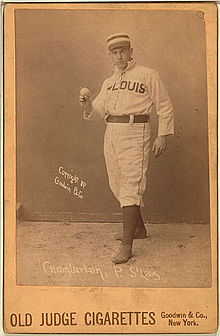
Elton P. "Ice Box" Chamberlain (November 5, 1867 – September 22, 1929) was an American professional baseball player. He played in the major leagues as a right-handed pitcher during 1886–1896. In several seasons, Chamberlain finished in his league's top ten in a number of pitching categories, including wins, earned run average, strikeouts, and shutouts. During one of his best seasons, the 1888 St. Louis Browns won the American Association pennant with a 92–43 record. Normally a right-handed pitcher, Chamberlain pitched the last two innings of an 1888 game with his left hand, making him a rare example of a switch pitcher.
Chamberlain finished his major-league baseball career with 264 complete games out of his 301 games started. After his playing days, he was hired as a baseball umpire and later announced he was becoming a boxer, but neither venture appears to have worked out. Not much is known about Chamberlain's later life. He died in Baltimore in 1929. (Full article...) -
Image 14

WDCA (channel 20), branded Fox 5 Plus, is a television station in Washington, D.C., serving as the local outlet for the MyNetworkTV programming service. It is owned and operated by Fox Television Stations alongside Fox outlet WTTG (channel 5). WDCA and WTTG share studios on Wisconsin Avenue in Bethesda, Maryland, and are broadcast on the same multiplex from a tower on River Road nearby.
WDCA began broadcasting as an independent station in April 1966. It was founded by the Capital Broadcasting Company, whose president was Washington broadcaster Milton Grant; Grant sold the station in 1969 to the Superior Tube Company of Pennsylvania but remained general manager until January 1980, leaving to start a career in broadcast station ownership. Channel 20 served as Washington's second-rated independent behind WTTG for decades and as a longtime home for local sports coverage and children's programming. (Full article...) -
Image 15"All the Way" (also known as "(Someday We'll Go) All the Way" and referred to as "Go All the Way") is a song written and performed by Evanston, Illinois native and Pearl Jam vocalist Eddie Vedder about the Chicago Cubs. It was first performed in public on August 2, 2007, recorded on August 21, 2008 and August 22, 2008, and released as a single on September 18, 2008.
At the time of the song's release in 2008, it had been 100 years since the Cubs had last won the World Series. Vedder has been a lifelong Cubs fan. The song, which fondly looks forward to the Cubs' next World Series victory, was written with the encouragement of certain Chicago Cubs, most notably Ernie Banks. The song was first performed in Chicago and was recorded over two nights in 2008 at the end Vedder's first solo tour. The song was accompanied by an official video release by the team following their victory in the 2016 World Series. (Full article...)
Did you know (auto-generated) - load new batch

- ... that Gaylord Perry admitted that he had cheated in baseball in his autobiography Me and the Spitter?
- ... that Cy Block and Ross Horning testified before the United States Congress about how the reserve clause limited their careers in professional baseball?
- ... that after the 1918 season, some Major League Baseball owners wanted the National Baseball Commission to be replaced by former president William Howard Taft?
- ... that before Sean Jackson won three Ivy League basketball championships, he won high school state championships in both baseball and basketball?
- ... that Salty Parker, who spent 60 years in organized baseball, described his lifelong love of the game as "a beautiful disease"?
- ... that baseball player Shane Rawley has published a novel?
- ... that Cam Booser retired from baseball to work as a carpenter in 2017 and made it to Major League Baseball in 2024?
- ... that Milt Wilcox, winning pitcher of Game 3 of the 1984 World Series, credited "throwing bowling balls" with rescuing his Major League Baseball career?
Quotes
| "We're so bad right now that for us back-to-back home runs means one today and another one tomorrow." |
 Featured lists - load new batch
Featured lists - load new batch
-
Image 1

David Ortiz has won the most Silver Slugger Awards as a designated hitter, with seven.
The Silver Slugger Award is awarded annually to the best offensive player at each position in both the American League (AL) and the National League (NL), as determined by the coaches and managers of Major League Baseball (MLB). These voters consider several offensive categories in selecting the winners, including batting average, slugging percentage, and on-base percentage, in addition to "coaches' and managers' general impressions of a player's overall offensive value". Managers and coaches are not permitted to vote for players on their own team. The Silver Slugger was first awarded in 1980 and is given by Hillerich & Bradsby, the manufacturer of Louisville Slugger bats. The award is a bat-shaped trophy, 3 feet (91 cm) tall, engraved with the names of each of the winners from the league and plated with sterling silver.
From 1980 to 2019, and in 2021, a Silver Slugger Award for designated hitters (DH) was only given in the American League, because use of a DH in place of the pitcher in the batting order was prohibited in the National League; a Silver Slugger Award for pitchers was given for the National League instead. In the 2020 season, the National League temporarily allowed use of the designated hitter, and no pitcher was awarded the Silver Slugger Award. An award was given instead to the best designated hitter in the National League. The first NL Silver Slugger Award for designated hitter was given to Marcell Ozuna. Beginning in 2022, the pitcher Silver Slugger Award was retired after MLB announced the full-time implementation of the universal DH rule in both leagues. The Silver Slugger Award for DH is now awarded in both leagues. (Full article...) -
Image 2
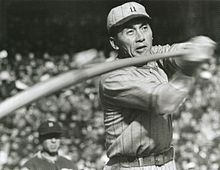
Fumio Fujimura was the first player in Nippon Professional Baseball history to hit for the cycle and also the first to hit multiple cycles.
In baseball, completing the cycle is the accomplishment of hitting a single, a double, a triple, and a home run in the same game. Collecting the hits in that order is known as a "natural cycle", which has occurred five times in Nippon Professional Baseball (NPB). The cycle itself is rare in NPB, occurring 76 times since Fumio Fujimura's first cycle during the single league era in 1948. In terms of frequency, the cycle is roughly as common as a no-hitter (90 occurrences in NPB history); Baseball Digest calls it "one of the rarest feats in baseball". Hitting for the cycle was not recognized in Japanese professional baseball until former Major League Baseball (MLB) player Daryl Spencer made a remark about it after hitting for the cycle with the Hankyu Braves in 1965. Of the 12 current NPB teams, only the Tohoku Rakuten Golden Eagles have never had at least one player hit for the cycle.
The most cycles hit by a player in Nippon Professional Baseball is three, accomplished by Bobby Rose. Playing for the Yokohama BayStars, Rose hit his first cycle on May 2, 1995, the next on April 29, 1997, and his final cycle on June 30, 1999. Other than Rose, only three other NPB players have hit multiple cycles: Fumio Fujimura with the Osaka Tigers and Hiromi Matsunaga with the Hankyu/Orix Braves and Kosuke Fukudome with the Chunichi Dragons and the Hanshin Tigers, all with two. Fujimura is also the only player to have hit a cycle during both the single league era and the current dual league era. The 2003 NPB season saw the most cycles hit in a single season—five. That season also saw the only instance of cycles occurring in two different games on the same day: on July 1, hit by Atsunori Inaba of the Yakult Swallows and Arihito Muramatsu of the Fukuoka Daiei Hawks. The next day, Shinjiro Hiyama became the third player to hit for the cycle in two days. Conversely, the longest period of time between two players hitting for the cycle is one day shy of 6 years. The drought has lasted from Michihiro Ogasawara's cycle in 2008 until Rainel Rosario's in 2014. (Full article...) -
Image 3

Evan Longoria (2008) is the only Rays' first-round pick to win a Rookie of the Year Award with the team.
The Tampa Bay Rays are a Major League Baseball franchise based in St. Petersburg, Florida. The Rays (formerly the Tampa Bay Devil Rays) compete in the American League East division. Since the franchise was established in 1995, the Rays have selected 36 players in the first round. Officially known as the "First-Year Player Draft", the Rule 4 Draft is Major League Baseball's primary mechanism for assigning amateur baseball players from high schools, colleges, and other amateur baseball clubs to its teams. The draft order is determined based on the previous season's standings, with the team possessing the worst record receiving the first pick. In addition, teams which lost free agents in the previous off-season may be awarded compensatory or supplementary picks. The First-Year Player Draft is unrelated to the 1997 expansion draft in which the Rays filled their roster.
Of the 36 players the Rays have selected in the first round, 10 have been outfielders and 12 have been drafted exclusively as pitchers. Of the 12 pitchers, eight were right-handed and four were left-handed. The Rays have also drafted five shortstops, four third basemen, two catchers, one second baseman, and one first baseman. In addition to these, one player (2017 pick Brendan McKay) was drafted as both a left-handed pitcher and a first baseman. Twenty players were drafted out of high school, 12 were drafted out of four-year colleges, and one was drafted from a junior college. Two players were drafted from Rice University in Houston, Texas in consecutive years. (Full article...) -
Image 4

John Lackey was the Angels' Opening Day starting pitcher in 2003 and 2007.
The Los Angeles Angels are a Major League Baseball (MLB) franchise based in Anaheim, California. They play in the American League West division. The franchise has also gone by the names "Los Angeles Angels", "California Angels" and "Anaheim Angels" at various points in its history. The first game of the new baseball season for a team is played on Opening Day, and being named the Opening Day starter is an honor, which is often given to the player who is expected to lead the pitching staff that season, though there are various strategic reasons why a team's best pitcher might not start on Opening Day. The Angels have used 25 different Opening Day starting pitchers in their 51 seasons. The 25 starters have a combined Opening Day record of 26 wins, 18 losses and 7 no decisions. No decisions are awarded to the starting pitcher if the game is won or lost after the starting pitcher has left the game. It can also result if a starting pitcher does not pitch five full innings, even if his team retains the lead and wins.
Jered Weaver has the most Opening Day starts for the Angels, with seven, and had 6 consecutive opening day starts from 2010 to 2015. He has a record of three wins and two losses, with one no decision in those starts that resulted in a win. Mike Witt has the second most starts, with five, with one win, three losses, and one no decision that resulted in a loss. Frank Tanana, Mark Langston and Chuck Finley have all made four Opening Day starts for the Angels. Hall of Famer Nolan Ryan, Bartolo Colón and Jered Weaver have each made three such starts for the Angels. (Full article...) -
Image 5

Keith Hernandez won eleven consecutive Gold Gloves at first base, the most by any MLB player.
The Gold Glove Award is the award given annually to the Major League Baseball players judged to have exhibited superior individual fielding performances at each fielding position in both the National League (NL) and the American League (AL), as voted by the managers and coaches in each league. Managers are not permitted to vote for their own players. Eighteen Gold Gloves are awarded each year (with the exception of 1957, 1985, 2007 and 2018), one at each of the nine positions in each league. In 1957, the baseball glove manufacturer Rawlings created the Gold Glove Award to commemorate the best fielding performance at each position. The award was created from a glove made from gold lamé-tanned leather and affixed to a walnut base. Initially, only one Gold Glove per position was awarded to the top fielder at each position in the entire league; however, separate awards were given for the National and American Leagues beginning in 1958.
Keith Hernandez has won the most Gold Gloves at first base, capturing 11 consecutive awards in the National League from 1978 to 1988. In the American League, Don Mattingly won nine times with the New York Yankees for the second-highest total among first basemen, and George Scott won eight awards playing for the Boston Red Sox (three) and the Milwaukee Brewers[a] (five). Vic Power[b], and Bill White each won seven awards; six-time winners include Wes Parker and J. T. Snow. Mark Teixeira has won five Gold Gloves at the position. Gil Hodges, Eddie Murray and Jeff Bagwell are the only members of the Baseball Hall of Fame to have won a Gold Glove at first base. (Full article...) -
Image 6
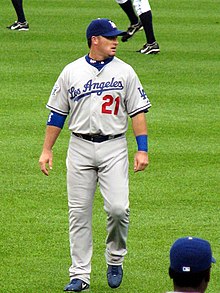
Mark Sweeney, the career pinch hit RBI recordholder, was named to the All-America Team in 1991 by both the American Baseball Coaches Association and Collegiate Baseball.
An All-American team is an honorary sports team composed of the best amateur players of a specific season for each position—who in turn are given the honorific "All-America" and typically referred to as "All-American athletes", or simply "All-Americans". Although the honorees generally do not compete as a unit, the term is used in U.S. team sports to refer to players who are selected by members of the national media. Walter Camp selected the first All-America team in the early days of American football in 1889. In 1950, the American Baseball Coaches Association (ABCA) selected its first All-American baseball team. It has since chosen All-American teams and a player of the year for each division (National Collegiate Athletic Association (NCAA) Division I, Division II, Division III, National Association of Intercollegiate Athletics, junior college and high school). In 1991, Collegiate Baseball began selecting college All-American, Freshman All-American, and High School All-American teams. Baseball America has selected – since 1981 – pre-season and post-season All-American teams and College Player of the Year honorees.
Various organizations selected All-American lists of the best players for the 1991 NCAA Division I college baseball season. The ABCA, the magazine Baseball America, and Collegiate Baseball were the NCAA-sanctioned selectors. This list only includes players selected to the post-season All-American first team for each selector. However, many All-American selections choose second, third, etc. teams from the remaining eligible candidates. (Full article...) -
Image 7

Team photograph of the 1888 Kansas City Cowboys
The Kansas City Cowboys were a professional baseball team based in Kansas City, Missouri that played in the American Association for two seasons from 1888 to 1889. The franchise initially used Association Park as their home field in 1888, then moved to Exposition Park for the 1889 season.
The team began the 1888 season with part-time outfielder Dave Rowe as their player-manager. He was released from the team after beginning the season with a win–loss record of 14–36 though 50 games. He was replaced with second baseman Sam Barkley, who did not improve the team's play, winning 22 of the next 58 games. He was replaced with non-playing manager Bill Watkins, who finished the season. Although the Cowboys completed their initial season in last place out of the league's eight teams, there were notable player achievements; on June 6, Henry Porter threw a no-hitter, and on June 13, Barkley hit for the cycle. (Full article...) -
Image 8
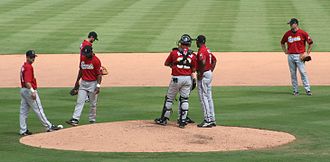
Pitching coach Stan Kyles meets with the Sounds' battery of Justin Lehr and J. C. Boscán on the mound.
The Nashville Sounds Minor League Baseball team has played in Nashville, Tennessee, since being established in 1978 as an expansion team of the Double-A Southern League. They moved up to Triple-A in 1985 as members of the American Association before joining the Pacific Coast League in 1998. With the restructuring of the minor leagues in 2021, they were placed in the Triple-A East, which became the International League in 2022. In the 2024 season, the Sounds' coaching staff was led by manager Rick Sweet and included Al LeBoeuf (hitting), Patrick McGuff (pitching and bullpen), Eric Theisen (hitting), David Tufo (bench), and Ned Yost IV (general).
Six former Sounds players later served as coaches for the team. Wayne Garland of the 1982 starting rotation returned as pitching coach from 1987 to 1988. Don Cooper, who pitched out of the bullpen in 1980, served as pitching coach from 1994 to 1996. Reliever Steve Wilson retired from the Sounds during the 1995 season and became the team's pitching coach. Fred Dabney, a reliever on the 1993 team, returned to coach pitchers from 2012 to 2014. Éric Gagné, who made two major league rehabilitation starts in 2008, served as bullpen coach in 2019. Jim Henderson, a reliever from 2011 to 2012 and in 2014, returned to the Sounds as pitching coach in 2021. Outfielder Gene Roof (1986) and catcher Buddy Pryor (1987) were player-coaches who coached hitting while also playing on the team. Two coaches also managed the Nashville club. Pitching coach Wayne Garland filled in as interim manager for three games in 1988 after the dismissal of manager Jack Lind. Richie Hebner, who was the hitting coach from 1998 to 2000, became the team's manager for the second half of the 2000 season when Trent Jewett was hired as the Pittsburgh Pirates' third base coach. Four coaches have been selected to participate in the Triple-A All-Star Game: Stan Kyles (2006), Rich Gale (2011), Bob Skube (2014), and Rick Rodriguez (2017). (Full article...) -
Image 9The Chicago Cubs are a professional baseball team based in Chicago, Illinois. The Cubs are members of the National League (NL) Central Division in Major League Baseball (MLB). In baseball, the head coach of a team is called the manager, or more formally, the field manager. The duties of the team manager include team strategy and leadership on and off the field. Since their inception as the White Stockings in 1876, the Cubs have employed 61 managers. The franchise's first manager was Baseball Hall of Famer Albert Spalding, who helped the White Stockings become the first champions of the newly formed National League.
After co-managing with Silver Flint during the 1879 Chicago White Stockings season, Hall of Famer Cap Anson began an 18-year managerial tenure in 1880, the longest in franchise history. Under Anson, the team won five more NL pennants — in 1880, 1881, 1882, 1885 and 1886—tying the 1885 World Series and losing the 1886 World Series in the process.[a] Anson won 1,283 games as the White Stockings' manager, the most in franchise history. After taking over for Hall of Fame manager Frank Selee in 1905, Frank Chance — another Hall of Famer — managed the team through the 1912 season. During his tenure, the franchise won four more NL pennants in 1906, 1907, 1908, and 1910, winning its only two World Series titles in 1907 and 1908 until 2016 Chance's .664 career winning percentage is the highest of any Cubs manager. After Chance, from 1913 through 1960, the Cubs employed nineteen managers, nine of which were inducted into the Hall of Fame. During this period, the Cubs won six more NL pennants, including three under manager Charlie Grimm. Split between Grimm's two managerial stints in the 1930s and 1940s, plus a brief appearance as manager in 1960, Grimm accumulated 946 career wins, second-most in franchise history behind Anson. (Full article...) -
Image 10

Mike Piazza is the all-time leader in Silver Slugger Awards among catchers, winning ten consecutive from 1993 to 2002.
The Silver Slugger Award is awarded annually to the best offensive player at each position in both the American League (AL) and the National League (NL), as determined by the coaches and managers of Major League Baseball (MLB). These voters consider several offensive categories in selecting the winners, including batting average, slugging percentage, and on-base percentage (OBP), in addition to "coaches' and managers' general impressions of a player's overall offensive value." Managers and coaches are not permitted to vote for players on their own team. The Silver Slugger was first awarded in 1980 and is given by Hillerich & Bradsby, the manufacturer of Louisville Slugger bats. The award is a bat-shaped trophy, 3feet (91cm) tall, engraved with the names of each of the winners from the league and plated with sterling silver.
Among catchers, Mike Piazza has won the most Silver Slugger Awards, with ten consecutive wins in the National League between 1993 and 2002; this is the most Silver Sluggers won consecutively by any player in Major League Baseball. In the American League, Iván Rodríguez has won the most Silver Sluggers, with six consecutive wins from 1994 to 1999, and a seventh when he tied with Víctor Martínez in 2004. Lance Parrish won the American League award six times (1980, 1982–1984, 1986, and 1990), and Joe Mauer, Jorge Posada and Salvador Pérez have won it five times; Mauer won in 2006, 2008–2010 and 2013, Posada won in 2000–2003 and 2007, and Pérez won it in 2016, 2018, 2020, 2021 and 2024. Hall of Famer Gary Carter (1981–1983, 1984–1986), Buster Posey (2012, 2014–2015, 2017, 2021), and Brian McCann (2006, 2008–2011) are five-time winners in the National League; McCann also won a sixth Silver Slugger in 2016, but in the American League. Other multiple awardees include Benito Santiago (four wins; 1987–1988, 1990–1991), J. T. Realmuto (three wins; 2018–2019, 2022), Mickey Tettleton (three wins; 1989, 1991–1992) and Carlton Fisk (three wins; 1981, 1985, 1988). William Contreras and Salvador Pérez are the most recent National and American League winners, respectively. (Full article...) -
Image 11

Roy Oswalt, the Houston Astros Opening Day starting pitcher for eight straight years, from 2003 through 2010.
The Houston Astros are a Major League Baseball (MLB) franchise based in Houston, Texas. They currently play in the American League West division. The first game of the new baseball season for a team is played on Opening Day, and being named the Opening Day starter is an honor, which is often given to the player who is expected to lead the pitching staff that season, though there are various strategic reasons why a team's best pitcher might not start on Opening Day.
The Astros began to play in 1962 as the Houston Colt .45s (their name was changed to the Astros in 1965 when the Houston Astrodome opened as their home ball park). Bobby Shantz started their first Opening Day game on April 10, 1962, against the Chicago Cubs at Houston's Colt Stadium and was credited with the win. In their first eight seasons, the Colt .45s / Astros used eight different Opening Day starters. In 1970, that streak ended when Larry Dierker made his second Opening Day start. (Full article...) -
Image 12
The All-Star Final Vote was an annual Internet and text message ballot by Major League Baseball (MLB) fans to elect the final player for each team that participates in the Major League Baseball All-Star Game, after all other selections were made and announced. The first 33 players were selected by a combination of procedures. The sponsorship changed annually, but the contest remained similar from year to year. Each league presented a five-man ballot and gave the fans a few days to choose one final All-Star. This process was used from 2002 through 2018. (Full article...) -
Image 13

Ryne Sandberg has the most wins among National League second basemen with seven Silver Slugger Awards.
The Silver Slugger Award is awarded annually to the best offensive player at each position in both the American League (AL) and the National League (NL), as determined by the coaches and managers of Major League Baseball (MLB). These voters consider several offensive categories in selecting the winners, including batting average, slugging percentage, and on-base percentage, in addition to "coaches' and managers' general impressions of a player's overall offensive value". Managers and coaches are not permitted to vote for players on their own team. The Silver Slugger was first awarded in 1980 and is given by Hillerich & Bradsby, the manufacturer of Louisville Slugger bats. The award is a bat-shaped trophy, 3 feet (91 cm) tall, engraved with the names of each of the winners from the league and plated with sterling silver.
Among second basemen, Ryne Sandberg, who played 15 seasons with the Chicago Cubs in his 16-year career, is tied for the most Silver Sluggers all-time with seven wins, and is first among all National League second basemen, including five consecutive from 1988 to 1992. Three other National League players have won the award four times. Jeff Kent (2000–2002, 2005) won three consecutive awards with the San Francisco Giants, before adding a fourth with the Los Angeles Dodgers; Craig Biggio, who played his entire career with the Houston Astros, won the award four times as a second baseman (1994–1995, 1997–1998) after winning another as a catcher. Chase Utley followed Kent's last win by capturing four consecutive awards (2006–2009). (Full article...) -
Image 14The Texas Rangers are an American baseball franchise based in Arlington, Texas. They are members of the American League West division. The Rangers franchise was formed in 1961, then called the Washington Senators, as a member of the American League. In its 62-year history, the Texas Rangers baseball franchise of Major League Baseball's American League has employed 28 managers. The duties of the team manager include team strategy and leadership on and off the field.
Mickey Vernon became the first manager of the then Washington Senators in 1961, serving for just over two seasons. Ron Washington has managed more games and seasons than any other manager in Rangers history. Before 2010, the only Rangers manager to have led the team to the playoffs was Johnny Oates, who also won the 1996 Manager of the Year Award with the Rangers. Ted Williams is the only Rangers manager to have been inducted into the Baseball Hall of Fame as a player; Whitey Herzog, who was inducted in the Hall in 2010, is only Rangers manager to earn induction as a manager. (Full article...) -
Image 15
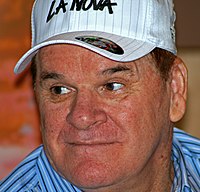
Pete Rose is the all-time MLB hits leader with 4,256 hits.
The 3,000-hit club is the group of 33 batters who have collected 3,000 or more regular-season hits in their careers in Major League Baseball (MLB). Reaching 3,000 hits has been "long considered the greatest measure of superior bat handling" and is often described as a guarantee of eventual entry into the Baseball Hall of Fame.
Cap Anson was the first MLB player to reach 3,000 hits, although his precise career hit total is unclear. Two players—Nap Lajoie and Honus Wagner—reached 3,000 hits during the 1914 season. Ty Cobb did so in 1921 and became the first player in MLB history to reach 4,000 hits in 1927, ultimately finishing his career with 4,191. Pete Rose, the current hit leader, became the second player to reach 4,000 hits on April 13, 1984, and surpassed Cobb in September 1985, finishing his career with 4,256. Roberto Clemente's career ended with precisely 3,000 hits, which he reached in the last at bat of his career on September 30, 1972. (Full article...)
More did you know
- ... that brothers George Wright and Harry Wright both managed the Providence Grays National League baseball team?
- ... that Mike Cather earned his first major-league win in an 11-inning Atlanta Braves’ win, the same night the Braves earned the National League Eastern Division title?
- ... that in 1975, his only full season, Stan Perzanowski's earned run average was the lowest on the Texas Rangers?
- ... that Josh Gibson Field in Pittsburgh, Pennsylvania, is named for Negro League star Josh Gibson, who has been called the "black Babe Ruth?"
- ... that Ryota Igarashi used to hold the Nippon Professional Baseball record for the fastest pitch thrown?
Sports portals
Selected picture
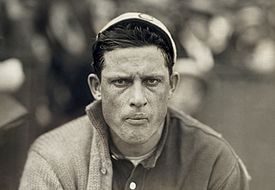
| Credit: Paul Thompson |
Edward Augustine Walsh (May 14, 1881 – May 26, 1959) was a Major League Baseball pitcher. He holds the record for lowest career ERA, 1.82. Born in Plains Township, Pennsylvania, Walsh had a brief though remarkable major league career. He made his major league debut in 1904 with the Chicago White Sox and pitched his first full season in 1906, going 17-13 with a 1.88 ERA and 171 strikeouts.
Associated Wikimedia
The following Wikimedia Foundation sister projects provide more on this subject:
-
Commons
Free media repository -
Wikibooks
Free textbooks and manuals -
Wikidata
Free knowledge base -
Wikinews
Free-content news -
Wikiquote
Collection of quotations -
Wikisource
Free-content library -
Wikiversity
Free learning tools -
Wiktionary
Dictionary and thesaurus
More portals
- Portals with triaged subpages from June 2018
- All portals with triaged subpages
- Portals with no named maintainer
- Automated article-slideshow portals with 51–100 articles in article list
- Automated article-slideshow portals with 501–1000 articles in article list
- Random portal component with 41–50 available subpages
- Automated article-slideshow portals with 201–500 articles in article list
- Random portal component with 11–15 available subpages
- Random portal component with 21–25 available image subpages

